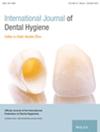Effectiveness of Chewing Gum After Water Rinsing in Removing Remnants of Sticky Cookies From Posterior Teeth—A Prospective Interventional Study
Abstract
Objective
To evaluate the effectiveness of chewing sugarless gum (SG) after water-rinsing in removing retained Oreo chocolate cookies (CC) from occlusal surfaces of teeth with and without fissure-sealant (FS).
Methods
A prospective study was performed on healthy children receiving prophylaxis at the paediatric-dentistry department. Immediately afterward, they chewed two CC. The occlusal surfaces of their posterior teeth were photographed 3 times: after 10 min, after 1 min of water-rinsing and after 4 min of chewing SG. An independent dentist screened all photos for the presence (partial or complete) or the absence of retained CC.
Results
Participants included 28 children 7–14-year-old, with 100 primary and 214 permanent molars, of which, 150 teeth had FS. After chewing two CC, 290 (92.4%) teeth had retained CC. Water-swishing removed all, partial or none of the CC in 23%, 72.4% and 4.6% of the teeth, respectively. The effectiveness of chewing SG in completely removing retained CC was significantly higher than water-rinsing (p < 0.001), OR = 43.83, Cramer's V value = 0.871, suggesting a very strong correlation.
The presence of FS raised the probability of completely removing retained CC after SG or water-rinsing (p < 0.001, OR = 107.7 and 25.9), with Cramer's V = 0.66 and 0.57, respectively, means a very strong association, as compared to teeth without (For both p < 0.001).
Conclusion
Chewing gum for 4 min was significantly more effective than water-rinsing for 1 min in removing retained CC. Moreover, FS considerably decreased the probability of retained CC on occlusal surfaces and increased the effectiveness of SG in removing it.

 求助内容:
求助内容: 应助结果提醒方式:
应助结果提醒方式:


